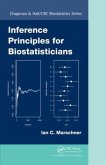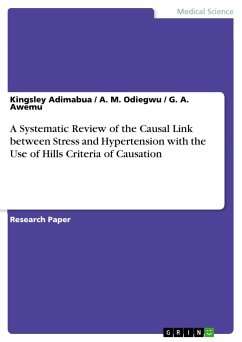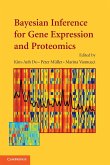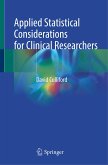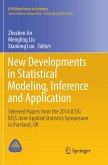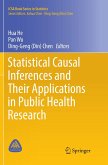- Gebundenes Buch
- Merkliste
- Auf die Merkliste
- Bewerten Bewerten
- Teilen
- Produkt teilen
- Produkterinnerung
- Produkterinnerung
Written by pioneers in the field, this practical book presents an authoritative yet accessible overview of the methods and applications of causal inference. The text provides a thorough introduction to the basics of the theory for non-time-varying treatments and the generalization to complex longitudinal data.
Andere Kunden interessierten sich auch für
![Inference Principles for Biostatisticians Inference Principles for Biostatisticians]() Ian C MarschnerInference Principles for Biostatisticians116,99 €
Ian C MarschnerInference Principles for Biostatisticians116,99 €![A Systematic Review of the Causal Link between Stress and Hypertension with the Use of Hills Criteria of Causation A Systematic Review of the Causal Link between Stress and Hypertension with the Use of Hills Criteria of Causation]() Kingsley AdimabuaA Systematic Review of the Causal Link between Stress and Hypertension with the Use of Hills Criteria of Causation15,95 €
Kingsley AdimabuaA Systematic Review of the Causal Link between Stress and Hypertension with the Use of Hills Criteria of Causation15,95 €![Bayesian Inference for Gene Expression and Proteomics Bayesian Inference for Gene Expression and Proteomics]() Bayesian Inference for Gene Expression and Proteomics90,99 €
Bayesian Inference for Gene Expression and Proteomics90,99 €![Applied Statistical Considerations for Clinical Researchers Applied Statistical Considerations for Clinical Researchers]() David CullifordApplied Statistical Considerations for Clinical Researchers41,99 €
David CullifordApplied Statistical Considerations for Clinical Researchers41,99 €![New Developments in Statistical Modeling, Inference and Application New Developments in Statistical Modeling, Inference and Application]() New Developments in Statistical Modeling, Inference and Application113,99 €
New Developments in Statistical Modeling, Inference and Application113,99 €![Neuro-Fuzzy Inference for Early Lung Cancer Detection Neuro-Fuzzy Inference for Early Lung Cancer Detection]() Ranga SwamyNeuro-Fuzzy Inference for Early Lung Cancer Detection24,99 €
Ranga SwamyNeuro-Fuzzy Inference for Early Lung Cancer Detection24,99 €![Statistical Causal Inferences and Their Applications in Public Health Research Statistical Causal Inferences and Their Applications in Public Health Research]() Statistical Causal Inferences and Their Applications in Public Health Research76,99 €
Statistical Causal Inferences and Their Applications in Public Health Research76,99 €-
-
-
Written by pioneers in the field, this practical book presents an authoritative yet accessible overview of the methods and applications of causal inference. The text provides a thorough introduction to the basics of the theory for non-time-varying treatments and the generalization to complex longitudinal data.
Produktdetails
- Produktdetails
- Verlag: Taylor & Francis Inc
- 1. Auflage
- Seitenzahl: 312
- Erscheinungstermin: 15. Dezember 2025
- Englisch
- Abmessung: 280mm x 210mm
- Gewicht: 453g
- ISBN-13: 9781420076165
- ISBN-10: 1420076167
- Artikelnr.: 23266590
- Herstellerkennzeichnung
- Libri GmbH
- Europaallee 1
- 36244 Bad Hersfeld
- gpsr@libri.de
- Verlag: Taylor & Francis Inc
- 1. Auflage
- Seitenzahl: 312
- Erscheinungstermin: 15. Dezember 2025
- Englisch
- Abmessung: 280mm x 210mm
- Gewicht: 453g
- ISBN-13: 9781420076165
- ISBN-10: 1420076167
- Artikelnr.: 23266590
- Herstellerkennzeichnung
- Libri GmbH
- Europaallee 1
- 36244 Bad Hersfeld
- gpsr@libri.de
Miguel Hernán conducts research to learn what works to improve human health. Together with his collaborators, he designs analyses of healthcare databases, epidemiologic studies, and randomized trials. Miguel teaches clinical epidemiology at the Harvard-MIT Division of Health Sciences and Technology, and causal inference methodology at the Harvard T.H. Chan School of Public Health, where he is the Kolokotrones Professor of Biostatistics and Epidemiology. His edX course "Causal Diagrams" is freely available online and widely used for the training of researchers. James Robins is a world leader in the development of analytic methods for drawing causal inferences from complex observational and randomized studies with time-varying treatments. His contributions include new classes of estimators based on the g-formula, inverse probability weighting of marginal structural models, and g-estimation of structural nested models. He teaches advanced epidemiologic methods at the Harvard T.H. Chan School of Public Health, where he is the Mitchell L. and Robin LaFoley Dong Professor of Epidemiology.
Part I: Causal inference without models 1. A definition of causal effect 2.
Randomized experiments 3. Observational studies 4. Effect modification 5.
Interaction 6. Graphical representation of causal effects 7. Confounding 8.
Selection bias 9. Measurement bias 10. Random variability Part II: Causal
inference with models 11. Why model? 12. IP weighting and marginal
structural models 13. Standardization and the parametric g-formula 14.
G-estimation of structural nested models 15 Outcome regression and
propensity scores 16. Instrumental variable estimation 17. Causal survival
analysis 18 Variable selection for causal inference Part III: Causal
inference from complex longitudinal data 19. Time-varying treatments 20.
Treatment-confounder feedback 21. G-methods for time-varying treatments 22.
Target trial emulation 23. Causal mediation
Randomized experiments 3. Observational studies 4. Effect modification 5.
Interaction 6. Graphical representation of causal effects 7. Confounding 8.
Selection bias 9. Measurement bias 10. Random variability Part II: Causal
inference with models 11. Why model? 12. IP weighting and marginal
structural models 13. Standardization and the parametric g-formula 14.
G-estimation of structural nested models 15 Outcome regression and
propensity scores 16. Instrumental variable estimation 17. Causal survival
analysis 18 Variable selection for causal inference Part III: Causal
inference from complex longitudinal data 19. Time-varying treatments 20.
Treatment-confounder feedback 21. G-methods for time-varying treatments 22.
Target trial emulation 23. Causal mediation
Part I: Causal inference without models 1. A definition of causal effect 2.
Randomized experiments 3. Observational studies 4. Effect modification 5.
Interaction 6. Graphical representation of causal effects 7. Confounding 8.
Selection bias 9. Measurement bias 10. Random variability Part II: Causal
inference with models 11. Why model? 12. IP weighting and marginal
structural models 13. Standardization and the parametric g-formula 14.
G-estimation of structural nested models 15 Outcome regression and
propensity scores 16. Instrumental variable estimation 17. Causal survival
analysis 18 Variable selection for causal inference Part III: Causal
inference from complex longitudinal data 19. Time-varying treatments 20.
Treatment-confounder feedback 21. G-methods for time-varying treatments 22.
Target trial emulation 23. Causal mediation
Randomized experiments 3. Observational studies 4. Effect modification 5.
Interaction 6. Graphical representation of causal effects 7. Confounding 8.
Selection bias 9. Measurement bias 10. Random variability Part II: Causal
inference with models 11. Why model? 12. IP weighting and marginal
structural models 13. Standardization and the parametric g-formula 14.
G-estimation of structural nested models 15 Outcome regression and
propensity scores 16. Instrumental variable estimation 17. Causal survival
analysis 18 Variable selection for causal inference Part III: Causal
inference from complex longitudinal data 19. Time-varying treatments 20.
Treatment-confounder feedback 21. G-methods for time-varying treatments 22.
Target trial emulation 23. Causal mediation


